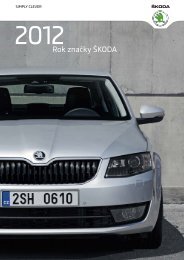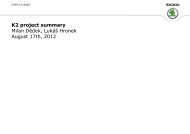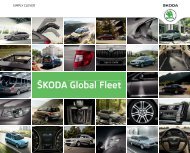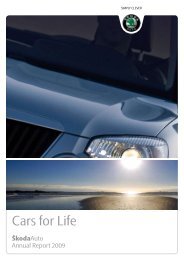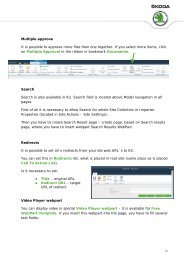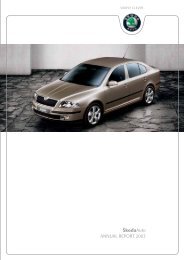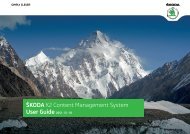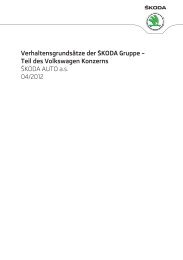Å kodaAuto ANNUAL REPORT 2006 - Skoda Auto
Å kodaAuto ANNUAL REPORT 2006 - Skoda Auto
Å kodaAuto ANNUAL REPORT 2006 - Skoda Auto
You also want an ePaper? Increase the reach of your titles
YUMPU automatically turns print PDFs into web optimized ePapers that Google loves.
1.11 Deferred income tax<br />
Deferred income tax is provided in full, using the liability method, on temporary differences arising between the tax bases of assets and<br />
liabilities and their carrying amounts in the consolidated financial statements. However, if the deferred income tax arises from initial<br />
recognition of an asset or liability in a transaction other than a business combination that at the time of the transaction affects neither<br />
accounting nor taxable profit nor loss, it is not accounted for.<br />
Deferred income tax is determined using tax rates and tax laws, that have been enacted by the balance sheet date and are expected to<br />
apply when the related deferred income tax asset is realised or the deferred income tax liability is settled. Deferred income tax assets are<br />
recognised to the extent that it is probable that future taxable profit will be available against which the temporary differences can be<br />
utilised.<br />
In accordance with IAS 12, deferred tax assets and liabilities are offset if the deferred tax assets and liabilities relate to income taxes levied<br />
by the same taxation authority, and where the companies of the Group have the enforceable right to offset the current tax assets and<br />
liabilities.<br />
Deferred tax relating to items recognised directly in equity (for example the effective portion of changes in the fair value of financial<br />
derivates that are designated and qualify as cash flow hedges) is also recognised directly in equity.<br />
The Group recognizes deferred income tax assets on unused investment tax credits against deferred tax income in the income statement to<br />
the extent that it is probable that future taxable profits will be available against which the unused tax credits can be utilized.<br />
1.12 Inventories<br />
Purchased inventories (raw materials, consumables, supplies and materials used in production, goods) are stated at the lower of cost and<br />
net realisable value. Costs include purchase costs and other acquisition costs (e.g. transport, customs duty, and packaging).<br />
Inventories generated from own production, i.e. work in progress and finished goods, are stated at lower of own production costs or net<br />
realisable value. Own production costs include direct material, direct wages and production overheads. The administration overhead<br />
expenses are not included in the valuation of work in progress and finished goods.<br />
Net realisable value is the estimated selling price in the ordinary course of business, less estimated costs of completion less applicable<br />
variable selling expenses. Net realisable value reflects all risks of obsolete and redundant raw materials and excessive spare parts.<br />
A weighted-average calculation is used to account for the consumption of materials and for all sales.<br />
71







